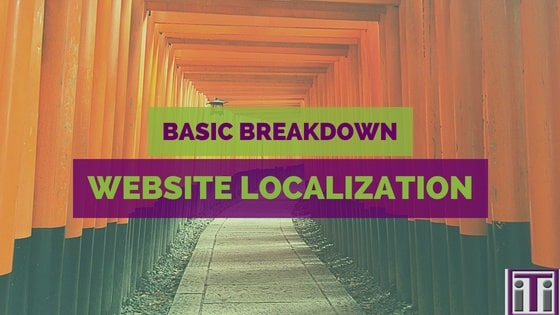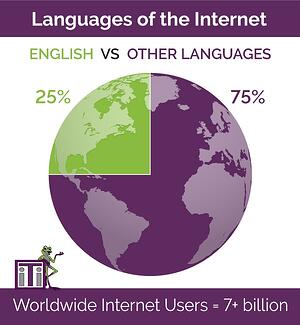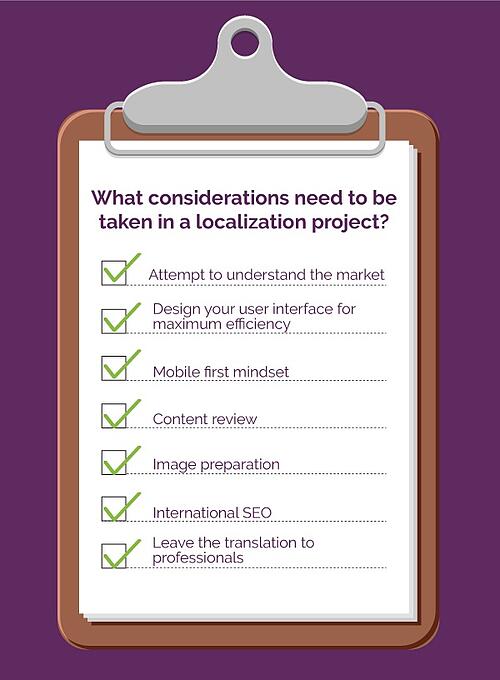Welcome to our “Basic Breakdown” series where we share all our insider knowledge on the types of language services and solutions possible for a variety of industries. Our goal is to help alleviate confusion between the many options offered by LSP’s to help arm you with the knowledge YOU need to make the best decisions for your organization.

Throughout the past several years, localization has become an increasingly common buzzword within the translation industry. So, how does it differ from translation and what exactly is it?
Localization is the process of modifying and adapting content to appeal to a new audience, typically in a completely different demographic from the original audience the content was created for. Translation, on the other hand, is the process of converting a source text from one language to another.
Localization combines content translation with cultural adaptation. Localization is viewed by some as more art than science because different cultures interpret information in unique ways based on the cultural framework they were raised in.
The goal of this blog is to give you an overview of website localization services. You will learn:
- Why localizing your website is necessary
- Variables that go into a website localization project
- How to avoid mistakes in localization projects
- Real-life examples of localization successes and failures
By the end of this article, you will be ready to enter a new region with maximum velocity! When website localization is executed correctly, you’re sure to see your sales skyrocket.
Why should you localize your website?

Did you know that 75% of internet users are non-native English speakers? That means that over 5 billion people worldwide are searching for products and services in a language other than English.
How do we know this?
Countless research has been done.
Bottom line:
People search in their native language. 76% of people would choose the product or service that offers information in their native language & 56% say the ability to obtain information in their native language is more important than price (Common Sense Advisory).

Translating and localizing your website and sales/marketing shows a commitment and courtesy to the new demographics as they see content tailored to their very own language and culture. It immediately builds credibility and trust.
More on The Importance of Website Localization
What considerations need to be taken in a website localization project?
Localizing your website ensures that your message is received as you intended for your customers. First, determine whether you are targeting a language or a specific region.
This will vary depending on your specific organization and goals but one way to get started is to review your website analytics and adhere to the 5% Rule.

Attempt To Understand The Market
You may know this to be true from being an English speaker: even when a common language and culture are shared, people will speak differently depending on their gender, age, and specific location.
To best reach your target market, identify as many defining characteristics for your target demographic as possible.
Understanding exactly how, where, when, and by whom your product or service is likely to be used is important for a successful localization effort.
Most importantly, there are often prejudices embedded within the language that speakers are quite sensitive to.
For example, Canadians may view European French speakers as pompous, while European French speakers find Canadian French to be outdated and overly traditional. As such. it would be a grave mistake to market to Canada’s Quebec province in anything besides Canadian French Canadian and vice versa.
Design Your User Interface for Maximum Efficiency
There are many variables at play when developing your site design to appeal to such a wide array of people.
You can take the simplified user interface (UI) route and offer a brief menu of different languages. This is appropriate for sites with a moderate reach and only need to cater to 2-5 main languages.
But for larger companies with vast global ambitions, this will not perform nearly as well. You will want to consider inserting code that will detect the users location and automatically offer the language spoken there. Or you can offer a pop-up that gives them the option to view the page in whichever language they choose.
There are many options here so be sure to give it thought up front so you don’t have to make time-consuming and costly changes down the line.
Mobile First Mindset
It’s no secret that mobile is a very big deal. Google’s algorithm is “mobile first” meaning that it considers your mobile site more important than your main desktop site.
Even if you operate in the B2B world, make sure you have at least a responsive design optimized for mobile.
No matter your industry or clientele, you must make sure that the user experience on mobile is impeccable.
Content Review
This stage will help ensure that your content goes through the least number of edits once it is translated. Before you send your content to a translation agency to be translated, proofread it over and over to be sure you are completely happy with it.
Keep your writing:
- Clear
- Simple
- Concise
Make sure that the writing is free of:
- Idioms
- Metaphors
- Puns
- Pop culture references
If your content meets these guidelines, you will avoid wasted resources by sidestepping unnecessary edits and the inevitable need for clarification.
Image Preparation
Imagery plays a pivotal role in any website localization project. How much customization is needed will depend on the specific project but none the less, it needs to be taken into consideration and addressed.
Limiting text in graphics and placing text into an editable layer, or having access to the source file, will streamline the translation process.
There are many other variables to consider when choosing the actual imagery to display such as the significance of color to whether or not women should be present. Or whether you should place a larger emphasis on groups of people collaborating versus individuals.
The safest strategy is to consult with your translation agency partner before creating images meant for different regions.
The time you invest in this step will be worth its weight in gold, simply by avoiding cumbersome, resource-intensive delays later on and the potential of lost business due to a cultural faux pas.
International Search Engine Optimization (SEO)
Another factor intrinsic to global success is your SEO strategy. Alternative search engines besides Google are gaining steam in international markets.
As of June 2018, Google owns 90% of the worldwide market share (GlobalStats). However, if you’re targeting China, you won’t want to discount Baidu.
Many of the basic SEO principles that you employ in English will remain the same in the global market. However, you will need to work with specialists to determine the best way to translate your keywords and consult on your overall SEO translation strategy.
How people search will be different depending on the framework they were raised in. It’s not as simple as translating your English keywords verbatim. Cultural influence plays a major role here as well as the upcoming popularity in voice search.
Leave Translation To The Professionals
Lastly, the best way to avoid embarrassing gaffes is to work with a professional translation service company that has experience with website localization and works with native speakers of the language you plan to target or in country specialists in the country you are targeting.
Choosing the correct words for the right message while still remaining faithful to your core message is a delicate art. One misstep can be costly.
Avoid these mistakes in a localization project

Picture this for a moment:
You’ve got a great new product to market to people in a new country. You’ve translated the documents into Dutch, German, Arabic or whatever language people speak in that country. Your advertising campaign starts and you wait for sales to pour in. They don’t.
What happened?
Your marketing might have flopped because of poor localization. Sure, the words you used are accurate in the technical sense. But your message doesn’t connect with or turns off native speakers of the language.
How do you avoid this translation scenario?
Here are five tips:
1) Make sure that you or your translation agency partner knows the cultural customs of the country and area.
Are you a beef company trying to sell your products in India? That can be a mine field.
Or perhaps your advertising used a picture of a woman with long hair in a Middle Eastern country? Many people in the Middle East are offended when they see photographs of a woman without a veil.
Work with a partner who knows the cultural differences between your country and the country you’re targeting. Better yet, be sure the partner has local resources in the country. Translators who are native speakers can point out what will work and what won’t in your advertising campaign. They can give you the viewpoint of the local people.
2) Use proper punctuation and grammar.
Your documents may be translated properly and still not look right from a native’s standpoint. Be aware of grammatical and spelling idiosyncrasies when you create documents for use in another country.
3) Use the right version of the language.
Some languages, like Spanish, have many versions. If your project is global, then you may want to use “global” Spanish. But if you’re marketing only in Peru or only in Colombia, be sure to request Peruvian Spanish or Colombian Spanish.
4) Check for local slang and double meanings.
Innocent wording in your language may translate into a phrase that confuses or offends people in another country. Every word and phrase you use must be appropriate for the target culture.
5) Ask for a lot of feedback and listen to it.
Language is subjective and reactions can be strong when it comes to marketing or stylistic texts.
Allow time in your production schedule for a final refinement step where feedback from reviewers is analyzed, harmonized (if more than one reviewer is participating) and implemented. Reputable translation agencies will perform an in-country review for you but if you have any employees native to that country or resource in country, be sure to ask for their feedback as well.
Even giant’s occasionally tip (Localization Fails)
Advertising history is ripe in large corporations with millions to throw at marketing companies, only to have their localization efforts fail in spectacular fashion.
When Gerber went to sell its products in South Africa, they get their signature label which has the face of a baby. The company ran into problems there. Since South Africa has low literacy rates, it’s common for packaging to show photos of what’s inside the container. Uh-oh….

Another well-known case of translation gone wrong is that of Coors.
The U.S. Colorado brewing company, Coors’ “Turn It Loose” slogan translated into Spanish as “Suffer from Diarrhea.” This is not exactly an enticing tagline for Spanish speakers.

Pepsi faced some blow-back from an infamous campaign in China that went from hilarious to horrifying rather quickly. The slogan “come alive with the Pepsi generation” was translated as “Pepsi brings your ancestors back from the grave”. Quite a claim to back up!

Localization entails more than just translation to a certain dialect. Many factors need to be considered such as local culture, history, social norms, and religion.
Interested In Localization Success Stories?
Bringing It All Together
Now that you understand that website localization is crucial to success on the global stage, here is the rundown of the key components that you will need to address for an effective localization project.
- Determine whether you are targeting a language or a region
- Decide on the proper website structure for your goals
- Review all your website content and imagery to:
- Ensure there are no typos or errors or culturally ambiguous language
- Ensure everything is written clearly and concisely
- Review imagery to determine if it is appropriate for the new market you are targeting
- Research and attempt to understand the new market you are targeting
- Ask for local feedback and listen
With so many factors at play and various regions to consider it’s easy to see why your international strategy deserves significant focus, time and attention. With the right Language Service Provider at your side there are no barriers between your organization and the new regions to grow into.
About Interpreters and Translators, Inc.
iTi’s dedicated and experienced team offers a wide range of multilingual solutions for domestic and global corporations in a variety of industries. Do you require translation services to enhance your global marketing and sales initiatives or interpreter services to communicate across languages? We specialize in custom language solutions and work with over 200 languages so regardless of the barrier you face, we will work together in synergy to bridge the gap to ensure success. Please feel free to contact us through a message or by calling 860-362-0812. Our offices are open 24/7/365 so we can respond immediately to your interpreting or translation needs anytime, anywhere.






Comments are closed here.